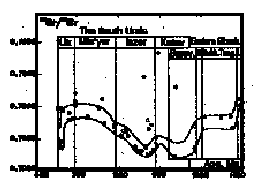
Geochemical contraints on the structure of the Earth's mantle are largely based on attempts to balance element fractionation between the continental crust and mantle using Nd-Sr isotope ratios and element abundances. Most mass balances assume that the source of mid-ocean ridge basalts (MORB) approximates the mantle complement to the continents (e.g. Galer et al., 1989, and refs. therein). Such calculations are used as evidence for convective separation between a depleted upper and a primitive lower mantle. Oceanic island basalt (OIB) sources have been ignored, and assumed to be negligible, mainly due to the absence of constraints on its size, element budget, and mean isotopic composition. If OIB sources contain a significant portion of mantle trace elements, inferences about the gross structure and composition of the mantle a simple continents-MORB source mass balance have to be re-evaluated. Here we constrain trace element distributions between OIB-, MORB-, and primitive mantle, and show that a major portion of the incompatible trace elements in the mantle reside in "OIB-" or "enriched-mantle" reservoirs.
We estimate the fraction of mantle "residual" to continent formation (MORB+OIB mantle) by balancing Ce/Pb and Nb/U in the continents and mantle. Their constancy in oceanic basalts (25±5 and 47±10, respectively) over a large compositional range suggest that they approximate the mantle sources (Hofmann, 1986). They are lower in primitive mantle (~11 and ~30, respectively (Hofmann, 1988; Miller et al., 1994)), and lower still in the continental crust. The mass balance is independent of isotope ratios, and unlike those based on Nd-Sr isotopes, it accounts for MORB and OIB sources. These ratios were previously used to mass balance three reservoirs (continents, primitive mantle, and OIB+MORB mantle) (Hofmann, 1986, 1988). Here we extend it to a four reservoir system in which OIB and MORB sources are treated as separate reservoirs.
The existence of "enriched" (non-MORB) mantle is directly indicated by the mass balance, because incom-patible element concentrations in the residual (non-primitive) mantle are too high for MORB mantle sources (Miller et al., 1994; Plank and Langmuir, 1992). We first remove the "excess" amounts of each element from the residual mantle to create a reasonable MORB source (e.g. Ce~0.8 ppm). We then create "OIB-" or "enriched-" mantle by mixing the excess trace elements with a fraction of MORB mantle, until the Ce abundance is appropriate for producing parental OIB magmas. Its mass depends on its assigned Ce abundance (we use 2-4 ppm). The OIB-source cannot be made by adding the excess elements to primitive mantle, because such a mixture has Ce/Pb much lower than MORB and OIB.
In practice, the mass of primitive versus residual mantle depends on the Ce and Pb abundances assigned to the continental crust. We use recent estimates for Ce as limiting values, which cover a large range from 33-60 ppm (Taylor and McLennan, 1985; Wedepohl, 1995). Pb is even less well-known than Ce, and we limit it only by the requirement that a mass balance cannot use more of an element than exists in the silicate Earth. As a result, our mass balance allows a large range of masses for residual (28-100%) and primitive mantle, similar to limits given by inversion modelling (e.g. Allégre et al., 1983).
The results nonetheless show several robust features. (1) The OIB-mantle reservoir always contains a large fraction of the incompatible trace elements, comparable to the MORB mantle reservoir, although its size is much smaller than MORB mantle. For example, the amount of Th-U-Nb in OIB-like sources is 1-1.5 times that of MORB mantle; for La-Ce it is 0.5-1.1 times as large. If the amount of primitive mantle is small, OIB-like mantle is the largest mantle reservoir for these elements. (2) The OIB-mantle trace element pattern is similar to Hawaiian tholeiites, that is, LREE enriched (147Sm/144Nd =0.14-0.16) and depleted in the most highly incompatible elements. This result has implications for modelling
of mantle melting which assumes a source REE pattern (e.g. McKenzie and O'Nions, 1991), and its implications for Nd isotopes limit the age of most OIB sources to be <1 Ga. (3) Although the input parameters we used allow for a residual mantle comprising 28-100% of the whole mantle, the limiting values require extreme input perameters. If the mantle is 28% residual, then the entire lower mantle can be primitive. However, this result is only found with the lowest continental Ce abundance and a Ce/Pb higher than any published crustal estimate. Most credible models require MORB- and primitive mantle sources to coexist in the lower mantle, even if most of the OIB-like mantle is in the D'' layer. In this case, it might be expected that convective mixing would lead to the generation of lower mantle with intermediate Sr and Nd isotope ratios, possibly similar to FOZO (Hart et al., 1992). However, such mixing would also result in Ce/Pb and Nb/U between primitive mantle values and those observed in MORB. As intermediate Ce/Pb and Nb/U are not observed in most OIB, except perhaps in oceanic plateaus, the lower mantle appears to contain separated primitive and residual mantle masses. Reconciliation of these geochemical reservoirs with physical locations in the mantle remains an intriguing problem.
Allègre, C.J., Hart, S.R. & Minster, J.-F., Earth Planet. Sci. Lett. 66, 191-213 (1983).
Galer, S.J.G., Goldstein, S.L. & O'Nions, R.K., Chem. Geol. 75, 257-290 (1989).
Hart, S.R. et al., Science 256, 517-520 (1992).
Hofmann, A.W. et al., Earth Planet. Sci. Lett. 79, 33-45 (1986).
Hofmann, A.W., Earth Planet. Sci. Lett. 90, 297-314 (1988).
McKenzie, D. & O'Nions, R.K., J. Pet. 32, 1021-1091 (1991).
Miller, D.M., Goldstein, S.L. & Langmuir, C.H., Nature 368, 514-520 (1994).
Plank, T. & Langmuir, C.H., J. Geophys. Res. 97, 19749-19770 (1992).
Taylor, S.R. & McLennan, S.M., The Continental Crust: Its Composition and Evolution 1-312 (Blackwell Scientific Publications, Oxford, 1985).
Wedepohl, K.H., Geochim. Cosmochim. Acta 59, 1217-1232 (1995).
Fig. 1: open circles - limestones, solid circles - dolostones.